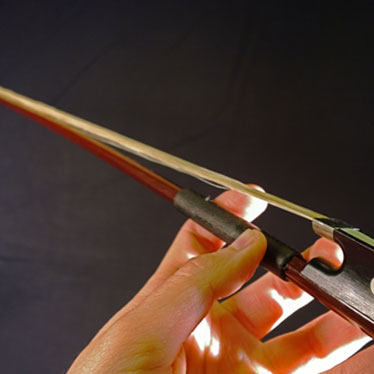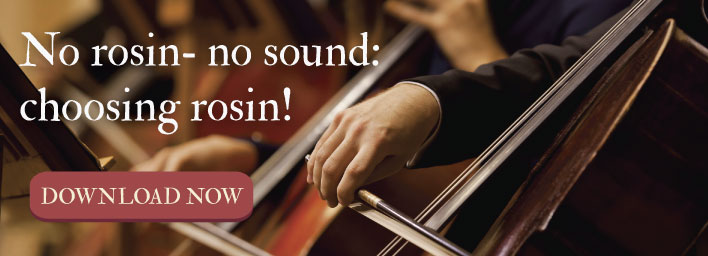Tips For Buying A Violin Bow

The difference in size between a violin and its bow isn’t a reflection of each piece’s relative importance. The right quality and fit of both pieces are needed for a violinist to produce music that inspires. While you may have invested tons of time researching and selecting the perfect violin, give your bow selection the same due diligence.
The beginning violinist has less to consider than the advanced student, or even someone looking to buy a professional grade bow. A beginner’s bow can cost between $50 - $200, while professional bows will cost thousands of dollars and antique bows even tens of thousands. If you’re an advanced student studying violin as a potential profession, don’t balk at paying anywhere from $500-$1200 for the right bow. The details of the bow do make a difference in the sound you can extract from your violin, as well as support or hinder your technique. This is no time to look for economies.
Criteria to consider when picking out a violin bow
The subjective criteria – and the most important criteria – to consider are how the bow feels in your hand and the sound it produces when you use it.
- Its weight and balance should make the bow feel like a natural extension of your arm and hand. You can look into actual weights of bows (the average violin bow weighs 60 grams), but the more important factor is how it feels to you and whether it feels natural when you play various bowing styles. Try a few different ones out, from legato to staccato. You also want to play different exercises or passages while holding the bow at different spots, from frog to tip.
- Assessing the differences in sound that different bows make requires a careful ear. If you can’t tell the difference in sound between two bows – all else being equal – select the less expensive bow and make refining your ear a priority. Come back each month to test out the more expensive bow and don’t buy it until you can hear the difference!
The materials used to make the bow have direct impact on its sound, but we’ll dig into specific materials a bit later. Right now, the point to understand is that the suppleness of the bow impacts the sound. A stiff bow produces a clearer sound and is probably easier for a beginner to handle. Yet a bow that’s very stiff and strong will produce a stiffer, rougher sound.
The shape of the bow also affects its stiffness. Most bows are round, which are a bit suppler. An octagonal bow will typically be stiffer than a round bow.
A bow that’s too soft can’t produce the clarity that showcases articulation and technique. So you want to get it just right. A bow with the correct amount of stiffness, while still feeling soft in the hand can produce a rich, smooth sound. The truth is, you’ll likely have to find the right compromise between responsiveness (stiffer) and richness (softer) rather than being able to find the perfect balance of the two.
When you’re in the selection process, play passages that you know from memory as your testers. Play each passage on the different bows you’re considering to hear for differences in the sound and comfort. Play them at normal speed and slow speed, so you can focus on the sound of each note. It’s also useful to play a single note with a long, slow bow to listen for tininess or unnecessary vibration.
What you need to know about the bow’s materials
Protected wood essence, preferred for centuries by bow makers, is the core of the pernambuco tree, growing mostly in Brazil. Pernambuco has been considered the gold standard for bow materials since the 18th century – the era of French bow masters such as Tourte, Pajot and Pecatte. This is due to its properties of density, stiffness, and springiness. The best contemporary bows may be cut in pernambuco sticks that have been aged for 50 to 200 years!
Brazilwood-made bows are much more affordable than pernambuco, but often don’t share the same stiffness and responsiveness properties as pernambuco. For that reason, for a similar price point, musicians tend to opt for bows made of synthetic material such as carbon fiber – which is stiffer, longer lasting if equipped with quality synthetic hair, and more responsive to a variety of bow strokes. Synthetic material bow construction allows for great consistency from one bow to another. So, if you have tried a carbon fiber bow made by a reputable brand in the past, you will likely be able to enjoy the same benefit buying the same model – something impossible with wood constructed bows.
Finally, most economic fiberglass does guarantee longevity but does not offer the same responsiveness as carbon fiber. If you play too long with such bows you may forget that a bow is your partner in sound making, not a slave!
A few more words about the hair
To be of high quality, bow hair needs to come from a white stallion. If not, a discoloration process, such as bleaching, will weaken it. With bows less than $500, you will most likely lose or break 1/3 of the hair if it is coming from a horse such as a brown mare. If you opt for a longer lasting synthetic fiber stick, go the whole way: opt for quality synthetic hair (we like French-made Coruss)…and leave the horse alone!
Decorations on the frog, the tip, and the windings vary, providing a level of elegance and beauty, as well as an impact on the overall weight, balance and even comfort of play. Look for a design that is pleasing visually and physically – but make sure it doesn’t include ivory, lizard skin or other banned elements.
Some bow buying process notes
If you are considering buying an antique bow, bring your violin and current bow along with you as you test them out. You want to hear and feel how the bows play on your instrument and be able to compare them to your current bow. Request to take it home for a few weeks, to allow testing described above. Show it to your teacher or/and a few violin stores to check quality, authenticity, and absence of any past, hidden repairs leading to loss of market value. Also make sure you get a certificate of authenticity from the dealer.
If you have an extra couple thousand bucks laying around, you can buy the definitive guide to bow craftsmanship L’Archet, published in 2000. Or, you can listen to this panel, which includes the book’s authors, on the art of bow making.


